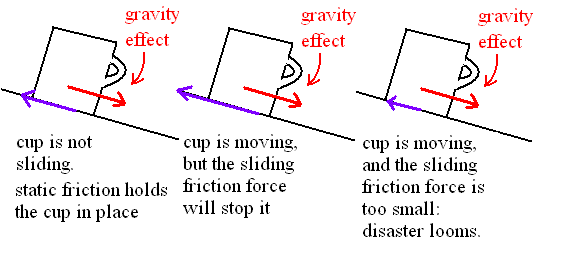
The word "friction" refers to the force one object exerts on another because they are in contact. However, there are two distinct cases: where one surface is moving relative to the other, and when they are not moving relative to one another.
Friction and forces
When we pull on an object, there are two possible outcomes: the object may move, or it may not. If the object does not move, it means that the surfaces that are touching it are exerting forces that balance the applied force, however large or small it may be. This is called "static friction" (where "static" means "not moving" in this context). There is no energy involved in static friction, because nothing has moved. In everyday life, static friction is very important to us, as you will know if you have ever tried to walk on smooth ice; it literally holds the world together.
There is a limit to how large a force static friction can oppose, that is determined by the nature of the surfaces in contact and by how hard they are being pressed together.
When this limit is exceeded, we encounter the second outcome, that one surface slides across the other. In this case there is a friction force that opposes the motion. Its size depends on the nature of the two surfaces and on how hard they are being pushed together, but does not depend very much on the relative speed.
Here is an example in which both kinds of friction force are involved:
if you place a cup of coffee on an sloped desk top, it might stay in place.
Static friction is holding the cup, and balancing the part of gravity that
would cause a ball to roll on this surface. But now if the desk is bumped
slightly, the cup is put in motion. Now sliding friction is opposing the
motion. If it is larger than the force pulling the cup, the cup will come
to a stop. But if it is too small, the cup will accelerate and will soon
land in your lap.

Note that there is no "right size" for the static friction force. It is just however big it needs to be to balance other forces on the cup. But the sliding friction force has a determined size, which may be larger or smaller than the other forces.
Sliding friction and energy
It is useful to discuss sliding friction in terms of energy loss.
As we push an object forwards, we are transferring energy to it. But when the object is in contact with others, it may give away some of this energy. For example,
Energy is conserved in all of these examples, but has been shared among many parts. We can't get back all the shared energy, and in this sense the energy has been lost (it still exists, but we no longer have it or can use it). This is why you can't roller skate on the beach: too much energy is used in moving the sand around, and not enough is left in the form of your kinetic energy.
For this reason, energy is transferred away from a moving object by the interaction with its surroundings. The transfer can be represented as a force that opposes the motion, which is the friction force.
The friction force on a sliding object doesn't depend much on the speed of the object. Sliding turns mechanical energy (like kinetic energy) into other forms, primarily heat. The sliding friction force is always in the direction opposite to the motion. From the point of view of forces and motion this seems a bit arbitrary: why couldn't the friction force be perpendicular to the direction of motion? However, a perpendicular force doesn't change the energy of the moving object. Friction is just a mechanism that removes energy from the sliding object, and the friction force only needs to be in the direction of the motion to accomplish this.
The assumption that the sliding force is independent of the relative speed is only an approximate model. There are counterexamples: if you try to push a boat through water, the opposing force (which we would still call friction, since it results from the sharing of energy with the environment) increases in proportion to the speed. The result is that a higher power motor on a boat causes it to go faster. At high speeds, wind resistance (which is proportional to the square of the speed) limits how fast a car can go.
Check the box when you are done:
Discussion of the unit on friction